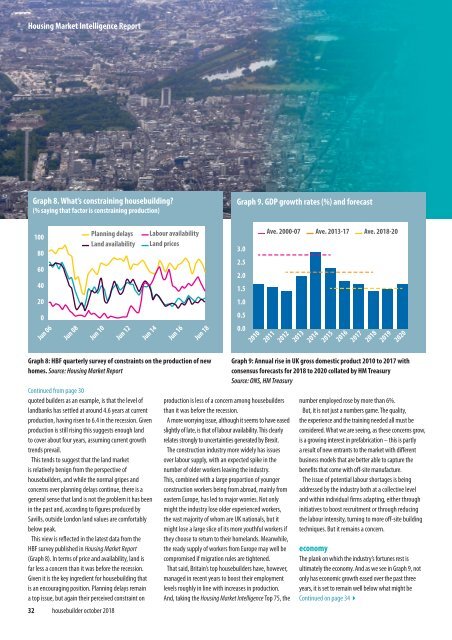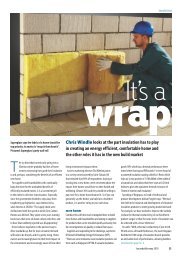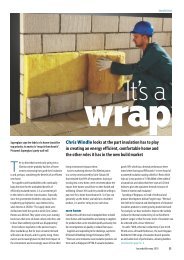Housebuilder October 2018
You also want an ePaper? Increase the reach of your titles
YUMPU automatically turns print PDFs into web optimized ePapers that Google loves.
Housing Market Intelligence Report<br />
Graph 8. What’s constraining housebuilding?<br />
(% saying that factor is constraining production)<br />
Graph 9. GDP growth rates (%) and forecast<br />
100<br />
80<br />
60<br />
40<br />
20<br />
0<br />
Jun 06<br />
Jun 08<br />
Planning delays<br />
Land availability<br />
Jun 10<br />
Graph 8: HBF quarterly survey of constraints on the production of new<br />
homes. Source: Housing Market Report<br />
Continued from page 30<br />
quoted builders as an example, is that the level of<br />
landbanks has settled at around 4.6 years at current<br />
production, having risen to 6.4 in the recession. Given<br />
production is still rising this suggests enough land<br />
to cover about four years, assuming current growth<br />
trends prevail.<br />
This tends to suggest that the land market<br />
is relatively benign from the perspective of<br />
housebuilders, and while the normal gripes and<br />
concerns over planning delays continue, there is a<br />
general sense that land is not the problem it has been<br />
in the past and, according to figures produced by<br />
Savills, outside London land values are comfortably<br />
below peak.<br />
This view is reflected in the latest data from the<br />
HBF survey published in Housing Market Report<br />
(Graph 8). In terms of price and availability, land is<br />
far less a concern than it was before the recession.<br />
Given it is the key ingredient for housebuilding that<br />
is an encouraging position. Planning delays remain<br />
a top issue, but again their perceived constraint on<br />
32 housebuilder october <strong>2018</strong><br />
Jun 12<br />
Labour availability<br />
Land prices<br />
Jun 14<br />
Jun 16<br />
Jun 18<br />
3.0<br />
2.5<br />
2.0<br />
1.5<br />
1.0<br />
0.5<br />
0.0<br />
production is less of a concern among housebuilders<br />
than it was before the recession.<br />
A more worrying issue, although it seems to have eased<br />
slightly of late, is that of labour availability. This clearly<br />
relates strongly to uncertainties generated by Brexit.<br />
The construction industry more widely has issues<br />
over labour supply, with an expected spike in the<br />
number of older workers leaving the industry.<br />
This, combined with a large proportion of younger<br />
construction workers being from abroad, mainly from<br />
eastern Europe, has led to major worries. Not only<br />
might the industry lose older experienced workers,<br />
the vast majority of whom are UK nationals, but it<br />
might lose a large slice of its more youthful workers if<br />
they choose to return to their homelands. Meanwhile,<br />
the ready supply of workers from Europe may well be<br />
compromised if migration rules are tightened.<br />
That said, Britain’s top housebuilders have, however,<br />
managed in recent years to boost their employment<br />
levels roughly in line with increases in production.<br />
And, taking the Housing Market Intelligence Top 75, the<br />
Ave. 2000-07 Ave. 2013-17 Ave. <strong>2018</strong>-20<br />
2010<br />
2011<br />
2012<br />
2013<br />
2014<br />
2015<br />
2016<br />
2017<br />
<strong>2018</strong><br />
2019<br />
2020<br />
Graph 9: Annual rise in UK gross domestic product 2010 to 2017 with<br />
consensus forecasts for <strong>2018</strong> to 2020 collated by HM Treasury<br />
Source: ONS, HM Treasury<br />
number employed rose by more than 6%.<br />
But, it is not just a numbers game. The quality,<br />
the experience and the training needed all must be<br />
considered. What we are seeing, as these concerns grow,<br />
is a growing interest in prefabrication – this is partly<br />
a result of new entrants to the market with different<br />
business models that are better able to capture the<br />
benefits that come with off-site manufacture.<br />
The issue of potential labour shortages is being<br />
addressed by the industry both at a collective level<br />
and within individual firms adapting, either through<br />
initiatives to boost recruitment or through reducing<br />
the labour intensity, turning to more off-site building<br />
techniques. But it remains a concern.<br />
economy<br />
The plank on which the industry’s fortunes rest is<br />
ultimately the economy. And as we see in Graph 9, not<br />
only has economic growth eased over the past three<br />
years, it is set to remain well below what might be<br />
Continued on page 34







